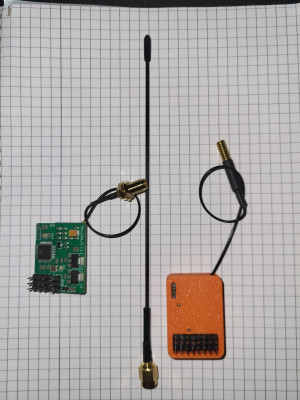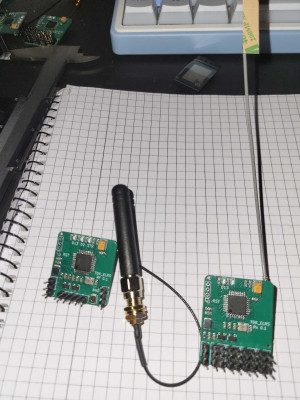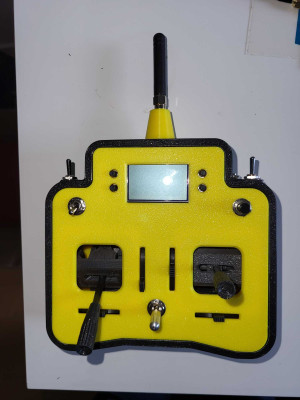Long time no see but things are taking shape in the Tobe's skunkworkshop,
not sure how I initiated the project over a year ago but it has been resting until a month or so ago after realizing that 2,4 GHz is getting crowded out there and several fields have "bad spots", must admit that my nRF24 system with the minimal packet is more resilient than many commercials but...thus I have started looking into a dual mode system but first I needed to squeeze out the most from a LoRa/ELRS kind system. Most "LoRa chips" are quite slow in switching frequencies so a pure spectrum became not feasible as they by the rules call for 47 channels and due of this the packet will not sent fast enough to update the servo position like it would be expected so I created this system based on GSFK modulation and a reduced channel hopping involving 4 channels randomly set in the bind procedure.
The system bind like my nRF24 system by using the unique ID of the MCU.
The good thing is that the same code fits all as the frequencies are set in the software just a matter to pick the right SX chip and tune the antennas accordingly.
Working on the project I realize that despite the frequencies are available w/o license the rules are quite stringent as duty cycle and output power, all of which I'm taking into account...to the best of my knowledge and my cheapie spectrum analyzer I should comply with, remaining question mark is, if it would be an option in the UK 458 MHz, it should...
Here follows a short description of how I intend it and got it to work.
Multi-Region GFSK RC System: Compact Packets, Maximum Reliability
GFSK is the same kind of modulation used in Bluetooth
System Overview
The RC control system leverages on GFSK (Gaussian Frequency Shift Keying) modulation with ultra-compact 10-byte packets to deliver exceptional reliability across multiple frequency bands. The system operates on 433MHz EU, 458MHz UK, 868MHz EU, and 915MHz US bands with automatic regional compliance, properly chosen in the code.
Core Architecture
Compact Packet Design
The system transmits all control data in just 10 bytes per packet:
- 8 bytes: Channel data (0-255 resolution per channel)
- 1 byte: Unique transmitter ID
- 1 byte: Packet type/sequence marker
This minimal packet size enables rapid 50ms transmission cycles while maximizing airtime efficiency and reducing interference exposure, it also incorporate a LBT feature to comply with EU rules with AFA-Adaptive Frequency Agility (AFA)
Multi-Layer Reliability
Frequency Agility: 4-channel frequency hopping within each band prevents single-frequency interference and regulatory compliance issues.
Dual Packet Types: Beacon packets (every 10th transmission) provide synchronization recovery, while regular packets carry control data with pseudo-random ID sequences set by the unique ID during binding..
Advanced Modulation: GFSK with BT=0.5 Gaussian filtering provides 2-3dB sensitivity improvement over basic FSK, translating to 25-40% range extension.
Flexibility Features
Regional Adaptability
Single code base automatically configures for local regulations:
- Power levels: 6mW (EU 433MHz) to 100mW (UK 458MHz)
- Channel spacing: 25kHz (458MHz) to 200kHz (868/915MHz)
- Bandwidth optimization: Narrow (25kHz) for spectrum efficiency, wide (50kHz) for high data rates
Intelligent Failsafe System
The failsafe setting of the Rx system captures actual stick positions on-demand from the Tx and saves it to the EEPROM storage: Survives power cycles and equipment changes
Hardware Compatibility
- Atmega 88P 8MHz 3.3v to avoid voltage dividers and shift level as the SX1278 is not 5 v tolerant.
- Radio flexible: Works with SX1276 & 78 chip
- PPM: Handles 950-2050μs PPM with corruption rejection
Technical Advantages
Speed and Latency
50ms transmission cycles with 60ms receive windows provide 20Hz update rates - compatible with most commercial servos while maintaining reliable packet reception windows.
Spectrum Efficiency
6kHz frequency deviation in 25kHz channels provides excellent adjacent channel protection while maximizing user capacity in congested bands.
Interference Immunity
- Pseudo-random hopping: 41-ID sequence prevents predictable interference
- CRC validation: Corrupted packets rejected at hardware level
- Whitening: DC-free encoding improves receiver performance
- Sync word filtering: 4-byte sync pattern eliminates false triggers
-LBT works w/o blocking as it doesn't resend the package but just jump to the next if the channel is busy and if one frequency/channels is busy it will at most loose 10 packets before next frequency/channel is called for.
Power Management
Watchdog protection, efficient transmission scheduling, and adaptive power control based on regional limits ensure reliable operation while maximizing battery life.
Operational Benefits
The combination of compact packets, intelligent frequency management, and robust error handling creates a system that maintains control authority even in challenging RF environments. Short packet duration minimizes interference windows, while multi-frequency operation provides automatic backup channels.
The hardware platform reduces inventory complexity across different regulatory regions.
The architecture proves that the protocol design with minimal packet overhead can achieve superior reliability compared to systems using larger, slower transmissions.

- 433 & 458 MHZ version

- 868 & 915 MHz version
As test bench I'm using my new mini-Tx designed especially to be compact...a slope Tx?
The Tx has mechanical trims and uses one of Mike's encoders so it's a full blown 8 channel set up with all the bells and whistles!

- My new mini-Tx is used as a test bench
 Fantastic work again mate
Fantastic work again mate